The Hindi Language
The story of the Hindi language is like an exciting journey through time in India. Hindi and Urdu are like close relatives because they come from the same language family called Indo-Aryan, and they started from an old language called Sanskrit.
Long ago, Sanskrit was an important language in India. It gave birth to other languages called Prakrits. Over time, these Prakrits changed and became Apabhramsha, which was like a bridge to modern languages like Hindi.
Hindi, as we know it now, began forming a very long time ago, around 7th to 13th centuries. During that time, Apabhramsha changed into many regional languages that people spoke in different parts of northern India. One of these early forms of Hindi was called “Braj Bhasha,” spoken in a place called the Braj region.
So, the history of Hindi is like an amazing adventure, full of changes and new languages along the way. It connects people from different places and helps us understand the diverse and wonderful culture of India.
Keep reading about, The Hindi Language
In the late 19th and early 20th centuries, people began recognizing Hindi and Urdu as separate languages.
They used different scripts, with Devanagari for Hindi and Perso-Arabic for Urdu, and they were influenced by Sanskrit and Persian, respectively.
The partition of India in 1947 further established Hindi and Urdu as the official languages of India and Pakistan, respectively.
Today, Hindi has become one of the most widely spoken languages in the world, with over 500 million speakers.
It serves as a means of communication and expression for people across various regions of India, while also making significant contributions to the country’s rich literary, artistic, and cultural heritage.
The history of the Hindi language reflects the intricate tapestry of Indian history and the profound influence of various cultures and traditions.
As Hindi continues to evolve and thrive, it remains a vital aspect of India’s identity and acts as a unifying force in this diverse and multilingual nation.
Read more about travel.
Read about tips for travel.
